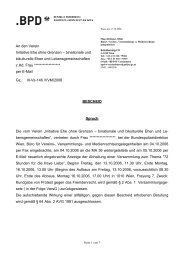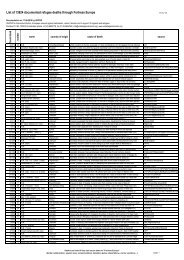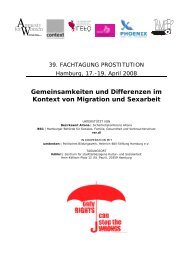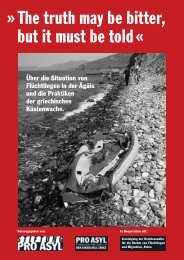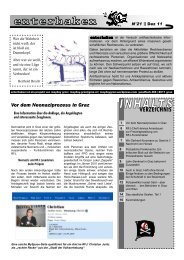Turin's CIE - International University College of Turin
Turin's CIE - International University College of Turin
Turin's CIE - International University College of Turin
You also want an ePaper? Increase the reach of your titles
YUMPU automatically turns print PDFs into web optimized ePapers that Google loves.
"1(A)(2) A person who owing to a well-founded fear <strong>of</strong> being persecuted for reasons <strong>of</strong><br />
race, religion, nationality, membership <strong>of</strong> a particular social group or political opinion, is<br />
outside the country <strong>of</strong> his nationality and is unable or, owing to such fear, is unwilling to<br />
avail himself <strong>of</strong> the protection <strong>of</strong> that country; or who, not having a nationality and being<br />
outside the country <strong>of</strong> his former habitual residence as a result <strong>of</strong> such events, is unable<br />
or, owing to such fear, is unwilling to return to it.”<br />
While the 1951 Convention Relating to the Status <strong>of</strong> Refugees <strong>of</strong>fers a broad range <strong>of</strong> rights, what<br />
is sought to be examined in this section is the condition <strong>of</strong> those detainees inside <strong>Turin</strong>’s <strong>CIE</strong><br />
who are asylum seekers and have not yet qualified for the level <strong>of</strong> protection guaranteed to a<br />
refugee, or those who have applied for a subsidiary protection status. The best practice<br />
standards for the procedure <strong>of</strong> determining a refugee application have been articulated in the<br />
UNHCR Handbook on Procedures and Criteria for Determining Refugee Status under the 1951<br />
Convention and the 1967 Protocol Relating to the Status <strong>of</strong> Refugees 140 and the Council <strong>of</strong><br />
Europe’s Guidelines on Human Rights Protection in the Context <strong>of</strong> Accelerated Asylum<br />
Procedures 141 .<br />
<strong>International</strong> law permits the detention <strong>of</strong> asylum seekers but restricts such actions by way <strong>of</strong><br />
Article 31(1) <strong>of</strong> the 1951 Convention Relating to the Status <strong>of</strong> Refugees, which disallows the State<br />
from imposition <strong>of</strong> penalties on irregular entrants in cases where they have come directly from<br />
a State where they claim to have been persecuted if “[…] they present themselves without delay<br />
to the authorities and show good cause for their illegal entry or presence”. Article 31(2) further<br />
restricts unnecessary prohibitions on movement:<br />
“31(2) The Contracting States shall not apply to the movements <strong>of</strong> such refugees<br />
restrictions other than those which are necessary and such restrictions shall only be<br />
applied until their status in the country is regularized or they obtain admission into<br />
another country. The Contracting States shall allow such refugees a reasonable period<br />
and all the necessary facilities to obtain admission into another country.”<br />
Furthermore, the UNHCR Revised Guidelines on Applicable Criteria and Standards relating to the<br />
Detention <strong>of</strong> Asylum-Seekers 142 and relevant Conclusions 143 together militate against detention<br />
and require the State to justify each individual detention decision as being necessary and for a<br />
specific purpose and to be as brief as possible. Detention is to be permitted only where it is<br />
necessary and lawful in order to verify identity, to determine the truth <strong>of</strong> the basis for an asylum<br />
claim, to deal with cases <strong>of</strong> destroyed or fraudulent identity documents or for national security<br />
or public order 144 .<br />
Moreover, the UNHCR Revised Guidelines on Applicable Criteria and Standards relating to the<br />
Detention <strong>of</strong> Asylum-Seekers state that “conditions <strong>of</strong> detention for asylum-seekers should be<br />
140 United Nations High Commissioner for Refugees, Handbook on Procedures and Criteria for Determining<br />
Refugee Status under the 1951 Convention and the 1967 Protocol relating to the Status <strong>of</strong> Refugees<br />
HCR/IP/4/Eng/REV.1 Reedited, Geneva, January 1992, UNHCR 1979.<br />
141 Committee <strong>of</strong> Ministers <strong>of</strong> the Council <strong>of</strong> Europe, Guidelines on human rights protection in the context <strong>of</strong><br />
accelerated asylum procedures, adopted by the Committee <strong>of</strong> Ministers <strong>of</strong> the Council <strong>of</strong> Europe on 1 July 2009<br />
at the 1062nd meeting <strong>of</strong> the Ministers’ Deputies.<br />
142 United Nations High Commissioner for Refugees, Revised Guidelines on Applicable Criteria and Standards<br />
relating to the Detention <strong>of</strong> Asylum-Seekers, UNHCR, 26 February 1999, Guidelines 2 and 3.<br />
143 United Nations High Commissioner for Refugees, Conclusion No. 44 (XXXVII) Detention <strong>of</strong> Refugees and<br />
Asylum-Seekers, ExCom, UNHCR, 37th Session, 1986, para. B.<br />
144 Id.; United Nations High Commissioner for Refugees, Conclusion No. 85 (XLIX) <strong>International</strong> Protection,<br />
ExCom, UNHCR, 49th Session, 1998, para. (w); United Nations High Commissioner for Refugees, Revised<br />
Guidelines on Applicable Criteria and Standards relating to the Detention <strong>of</strong> Asylum-Seekers, Guideline 3.<br />
76 | P a g e




